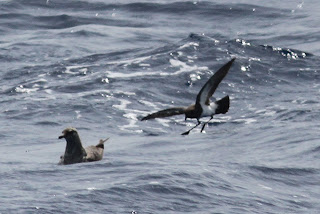Here's a photo of a similar looking 3cy bird taken today at Praia da Vitoria, Terceira - note the similarity in primary moult, solid brown greater-coverts and secondaries and all black tail. This bird, and the Irish bird, are both swarthy looking beasts with this image created by the paling iris set against dense head streaking. This bird has slightly more advanced bare part (bill) colouration, but that's about it.
Near adult/adult Azorean Gulls are all hooded by now, just like the Irish bird. The head streaking is always fine and densely packed and is rarely blotchy like you get in LBBGs. It seems that near-adult Azorean Gulls (so 4cy+) retain darker markings in their greater-coverts to later ages compared to other YLG taxa. Here are a few shots from today, of various individuals - compare with the Irish near-adult: -





















































